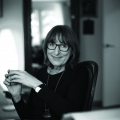
***
[z tomu alfabet, wydawnictwo Lokator 2018]
fruwająca czapla istnieje, szaroniebieski
łukowaty grzbiet, czarny czub
i ogon z jasnymi piórami; istnieje
w koloniach; w tak zwanym Starym Świecie;
istnieją też ryby; flamingi, fregaty, fletówki;
falowanie traw i barwy fagasów;
istnieją produkty rozszczepienia atomu i figowce;
istnieją błędy, fatalne, powtarzane,
przypadkowe; istnieją flamingi i fale zdalnego
sterowania; i fiołki, fiołki w sadzie w którym
istnieją antonówki, antonówki,
w krajach gdzie ciepło nasyca ich
miąższ barwą właściwą dla antonówek
Przełożyła Bogusława Sochańska
***
[z tomu alfabet, Kopenhaga 1981]
fiskehejren findes, med sin gråblå hvælvede
ryg findes den, med sin fjertop sort
og sine halefjer lyse findes den; i kolonier
findes den; i den såkaldt Gamle Verden;
findes også fiskene; og fiskeørnen, fjeldrypen
falken; festgræsset og fårenes farver;
fissionsprodukterne findes og figentræet findes;
fejlene findes, de grove, de systematiske,
de tilfældige; fjernstyringen findes og fuglene;
og frugttræerne findes og frugterne i frugthaven hvor
abrikostræerne findes, abrikostræerne findes,
i lande hvor varmen vil frembringe netop den
farve i kødet abrikosfrugter har

Inger Christensen, urodziła się w 1935 roku, zmarła w 2009 roku, wybitna przedstawicielka duńskiego postmodernizmu. Nietypowość poetki na tle literatury i myśli postmodernistycznej polega między innymi na tym, że przy całym pesymizmie dotyczącym człowieka i przyszłości, jej utwory przesycone są zachwytem nad urodą świata, który w magiczny sposób przekłada się na urzekające piękno jej poetyki. Debiutowała w 1962 roku. Spośród siedmiu tomów poetyckich wyróżniają się Det (To, 1969), alfabet (1981) i Sommerfugledalen (Dolina motyli, 1991). Jest także autorką m.in. powieści Evighedsmaskinen (Maszyna wieczności, 1964), Azorno (Azorno, 1967) i Det malede værelse (Komnata z malowidłem, 1976) oraz zbiorów esejów Del af labyrinten (Część labiryntu, 1982) i Hemmelighedstilstanden (Stan tajemnicy, 2000). Twórczość Christensen zdobyła międzynarodowe uznanie, a jej utwory tłumaczono na wiele języków. W języku polskim ukazał się jak dotąd tylko tom alfabet (2018). Pisarkę uhonorowano m.in. Nagrodą Nordycką Akademii Szwedzkiej (1994), Austriacką Nagrodą Państwową w dziedzinie literatury (1994), Grand Prix na Międzynarodowym Biennale Poezji w Liège (1995). Przez wielu europejskich krytyków uważana była za duńską kandydatkę do Nagrody Nobla. / fot. Rigmor Mydtskov
Inger Christensen, born in 1935, died in 2009, an outstanding representative of Danish postmodernism. The poet's uniqueness in the context of postmodernist literature and thought is manifested, for example, through the fact that despite the pessimism regarding man and the future, her works are saturated with admiration of the beauty of the world, which magically translates into the captivating beauty of her poetics. She made her debut in 1962. Among seven volumes of poetry, the most outstanding are Det (It, 1969), Alfabet (1981) and Sommerfugledalen (Butterfly Valley: A Requiem, 1991). She is also the author of novels Evighedsmaskinen (Eternity Machine, 1964), Azorno (Azorno, 1967) and Det malede værelse (The Painted Room: A Tale of Mantua, 1976) and collections of essays Del af labyrinten (Part of the Maze, 1982) and Hemmelighedstilstanden (The State of Secrecy, 2000). Christensen's work has gained international recognition and her works have been translated into many languages. In Polish, only alfabet (2018) has been published so far. Among many awards, she received Svenska Akademiens Nordiska Pris (1994), Der Österreichische Staatspreis für Literatur (1994) and Grand Prix at des Biennales Internationales de la Poesie de Liege (1995). Many European critics considered her a Danish candidate for the Nobel Prize. / fot. Rigmor Mydtskov

Bogusława Sochańska, tłumaczka, autorka tekstów krytycznoliterackich i esejów poświęconych duńskiej literaturze i kulturze. Absolwentka filologii duńskiej na UAM, gdzie w latach 1980-1995 wykładała w Katedrze Skandynawistyki m.in. historię literatury duńskiej i translatologię. Za najważniejsze w swoim dorobku uważa przekłady twórczości H.Ch. Andersena. Za pełne wydanie Baśni i opowieści, t. 1-3 (2006) otrzymała duńską Nagrodę im. H. Ch. Andersena. Za Andersen. Dzienniki 1825-1875 w jej wyborze, przekładzie i opracowaniu (2014) nominowana do Nagrody Literackiej Gdynia 2015 w kategorii Przekład. W 2016 nominowana do Nagrody Europejski Poeta Wolności jako tłumaczka tomu wierszy Yahyi Hassana. Wprowadziła do kultury polskiej prozę i poezję Janiny Katz, tłumaczyła ponadto m.in. prozę Stiga Dalagera i Knuda Romera, dramaty Astrid Saalbach i Susanne Brøgger, wiersze Pieta Heina, Marianne Larsen, Petera Laugesena, Henrika Nordbrandta. Jest laureatką Duńskiej Nagrody dla Tłumacza Literackiego 2014. / fot. Renata Dąbrowska
Bogusława Sochańska, translator, author of literary criticism texts and essays dedicated to Danish literature and culture. Graduate in Danish philology at Adam Mickiewicz University, where between 1980 and 1995, she was a lecturer in the history of Danish literature and translation studies at the Department of Scandinavian Studies. She considers her translations of H.Ch. Andersen’s works to be her greatest achievement. For the full edition of Baśnie i opowieści, (Fairy Tales and Stories) vol. 1-3 (2006) she received the Danish H. Ch. Andersen Award. For Andersen. Journals 1825-1875, selected, translated and developed by her (2014), she was nominated for the Gdynia 2015 Literary Award for Translation. In 2016, she was nominated for the European Poet of Freedom Award as the translator of a volume of poems by Yahyi Hassan. She introduced Janina Katz's prose and poetry to Polish culture, she also translated, for example, the prose of Stig Dalager and Knud Romer, dramas by Astrid Saalbach and Susanne Brøgger, and poems by Pieta Hein, Marianne Larsen, Peter Laugesen and Henrik Nordbrandt. She is a laureate of the Danish Prize for Literary Translator 2014. / fot. Renata Dąbrowska

